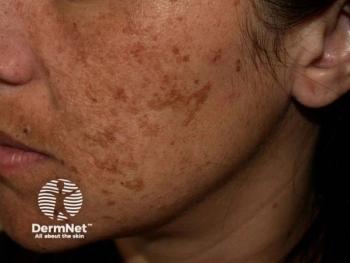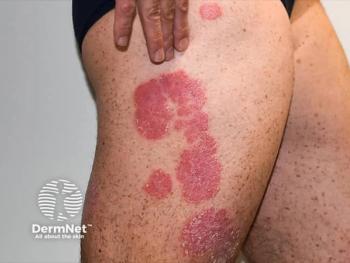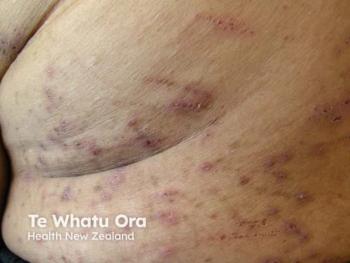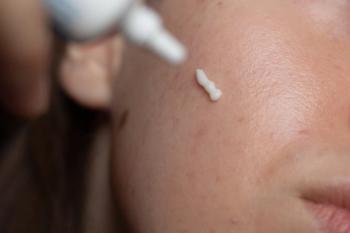
- Dermatology Times, June 2025 (Vol. 46. No. 06)
- Volume 46
- Issue 06
Larry Eichenfield, MD: Icotrokinra Demonstrates Promising Results for Adolescents With Moderate to Severe Plaque Psoriasis
Eichenfield discusses high skin clearance and safety in teens with psoriasis, per new ICONIC-LEAD phase 3 data.
New data from Johnson & Johnson’s phase 3 ICONIC-LEAD study suggest promise in the treatment of moderate to severe plaque psoriasis in adolescents. Icotrokinra (JNJ-2113), an investigational, first-in-class oral peptide that selectively targets the IL-23 receptor, demonstrated strong efficacy and a favorable safety profile in this population.
In the adolescent cohort, 84.1% achieved clear or almost clear skin (IGA 0/1) by week 16, compared to just 27.3% in the placebo group. By week 24, 75% of adolescent patients had completely clear skin (IGA 0), and 63.6% reached PASI 100. These findings, presented at the 2025 World Congress of Pediatric Dermatology, represent the first-ever phase 3 registrational study to evaluate a systemic psoriasis therapy in adolescents and adults simultaneously.1
In an interview with Dermatology Times, Lawrence (Larry) Eichenfield, MD, lead presenter of the ICONIC-LEAD data and chief of pediatric and adolescent dermatology at Rady Children’s Hospital-San Diego, spoke about the significance of the findings, the novel mechanism of icotrokinra, and what the future may hold for pediatric psoriasis care.
A New Class of Therapy: Oral Peptide That Blocks IL-23
What sets icotrokinra apart from other psoriasis therapies is its novel structure and mechanism of action. “This technology that is being brought to psoriasis is just eye-opening,” Eichenfield explained. “Because essentially, we're getting an oral peptide—so an oral agent that sort of works like a biologic agent, but it's not a biologic.”
Unlike monoclonal antibodies that require injection or infusion, icotrokinra is a small peptide designed to be taken once daily by mouth. “It’s an oral peptide. It’s designed to be given orally but blocks IL-23,” Eichenfield said. “We know IL-23 is highly important in the regulation of psoriasis with the cytokine profile that mediates psoriasis.”
Blocking IL-23 is a validated therapeutic strategy in adult plaque psoriasis, but to deliver this effect through a daily pill is “very exciting,” especially in a pediatric context, he emphasized.
Subgroup Results in Adolescents: Skin Clearance and Better Tolerability
The ICONIC-LEAD adolescent cohort included 66 patients. At week 16:
- 84.1% achieved an IGA score of 0/1 (clear or almost clear skin)
- 70.5% achieved PASI 90
- Only 50% of patients on icotrokinra reported 1 or more adverse events, compared to 73% on placebo
By week 24:
- 86.4% achieved IGA 0/1
- 88.6% achieved PASI 90
- 75% achieved IGA 0 (completely clear skin)
- 63.6% achieved PASI 100
These rates of near or total clearance are especially important in adolescents, Eichenfield noted. “Young patients with plaque psoriasis face unique challenges due to the visible and uncomfortable nature of the disease,” he said. “Making effective treatment options that align with their needs and preferences all the more important.”
The study design also allowed for a rapid rollover from placebo to active treatment in adolescents, which is ethically advantageous and clinically efficient. “The adolescents were on it in a sort of different context as compared to the adults in terms of duration of therapy and a rapid rollover of patients from the placebo,” Eichenfield said.
Addressing the Need for Advanced Therapies in Adolescents
Historically, adolescents with moderate to severe psoriasis have had limited access to systemic therapies, particularly those studied in their age group. As Eichenfield explained, “This is a population that often hasn't yet received advanced therapy, and this oral peptide option has the potential to change that.”
For adolescents and their families, a once-daily oral treatment that doesn’t compromise efficacy or safety is a welcomed advancement. “This sort of oral therapy that mimics the mechanism of biologics offers real promise,” Eichenfield said.
Looking Ahead
The ICONIC-LEAD study is part of the broader ICONIC clinical development program, which aims to redefine how systemic psoriasis treatments are evaluated across age groups.
“Adolescents living with moderate to severe plaque psoriasis shouldn't have to wait for effective treatment options that have the potential to deliver completely clear skin,” said Liza O'Dowd, MD, vice president, immunodermatology disease area lead at Johnson & Johnson Innovative Medicine.1 “These data underscore the promise of next-generation therapies and the potential for icotrokinra to offer adolescents with moderate to severe plaque psoriasis the unique combination of a favorable safety profile and complete skin clearance in a once-daily pill.”
Eichenfield echoed that optimism. “We’re just at the beginning of understanding the potential for this type of therapy,” he said. “It’s a really exciting time in pediatric dermatology, and I think the future is looking brighter for our young patients.”
Reference
- Icotrokinra results show 75% of adolescents with plaque psoriasis achieved completely clear skin and demonstrate favorable safety profile in a once daily pill. News release. Johnson & Johnson. April 10, 2025. Accessed April 17, 2025.
https://www.jnj.com/media-center/press-releases/icotrokinra-results-show-75-of-adolescents-with-plaque-psoriasis-achieved-completely-clear-skin-and-demonstrate-favorable-safety-profile-in-a-once-daily-pill
Articles in this issue
6 months ago
Dermatology Times June 2025 Print Recap6 months ago
Nail Trends That Challenge Clinical Diagnosis6 months ago
Inside IL-17 Inhibitors Advancing Psoriasis CareNewsletter
Like what you’re reading? Subscribe to Dermatology Times for weekly updates on therapies, innovations, and real-world practice tips.


















